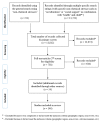State-of-the-Science Review of Non-Chemical Stressors Found in a Child's Social Environment
- PMID: 31718056
- PMCID: PMC6888402
- DOI: 10.3390/ijerph16224417
State-of-the-Science Review of Non-Chemical Stressors Found in a Child's Social Environment
Abstract
Background: Children are exposed to chemical and non-chemical stressors from their built, natural, and social environments. Research is needed to advance our scientific understanding of non-chemical stressors, evaluate how they alter the biological response to a chemical stressor, and determine how they impact children's health and well-being. To do this, we conducted a state-of-the-science review of non-chemical stressors found in a child's social environment. Methods: Studies eligible for inclusion in this review were identified through a search of the peer-reviewed literature using PubMed and PsycINFO. Combinations of words associated with non-chemical stressors and children were used to form search strings. Filters were used to limit the search to studies published in peer-reviewed journals from 2000-2016 and written in English. Publications found using the search strings and filters went through two rounds of screening. Results: A total of 146 studies met the inclusion criteria. From these studies, 245 non-chemical stressors were evaluated. The non-chemical stressors were then organized into 13 general topic areas: acculturation, adverse childhood experiences, economic, education, family dynamics, food, greenspace, neighborhood, social, stress, urbanicity, violence, and other. Additional information on health outcomes, studies evaluating both chemical and non-chemical stressors, and animal studies are provided. This review provides evidence that non-chemical stressors found in a child's social environment do influence their health and well-being in both beneficial (e.g., salutatory effects of greenspace and social support) and adverse (e.g., poor relationships between health and selected non-chemical stressors such as economics, educational attainment, exposure to violence, stress) ways. Conclusions: This literature review identified a paucity of studies addressing the combined effects of chemical and non-chemical stressors and children's health and well-being. This literature review was further complicated by inconsistencies in terminology, methodologies, and the value of non-chemical stressor research in different scientific disciplines. Despite these limitations, this review showed the importance of considering non-chemical stressors from a child's social environment when addressing children's environmental health considerations.
Keywords: children; exposure; non-chemical stressors; public health; social determinants of health.
Conflict of interest statement
The authors declare no conflict of interest.
Figures



References
-
- Tulve N.S., Ruiz J.D.C., Lichtveld K., Darney S.P., Quackenboss J.J. Development of a Conceptual Framework Depicting a Childs Total (Built, Natural, Social) Environment in Order to Optimize Health and Well-Being. J. Environ. Health Sci. 2016;2:1–8. doi: 10.15436/2378-6841.16.1121. - DOI
-
- Cohen Hubal E.A., de Wet T., Du Toit L., Firestone M.P., Ruchirawat M., van Engelen J., Vickers C. Identifying important life stages for monitoring and assessing risks from exposures to environmental contaminants: Results of a World Health Organization review. Regul. Toxicol. Pharmacol. 2014;69:113–124. doi: 10.1016/j.yrtph.2013.09.008. - DOI - PMC - PubMed
-
- Cohen Hubal E.A., Sheldon L.S., Burke J.M., McCurdy T.R., Berry M.R., Rigas M.L., Zartarian V.G., Freeman N.C. Children’s exposure assessment: A review of factors influencing Children’s exposure, and the data available to characterize and assess that exposure. Environ. Health Perspect. 2000;108:475. doi: 10.1289/ehp.108-1638158. - DOI - PMC - PubMed
Publication types
MeSH terms
LinkOut - more resources
Full Text Sources
Miscellaneous

